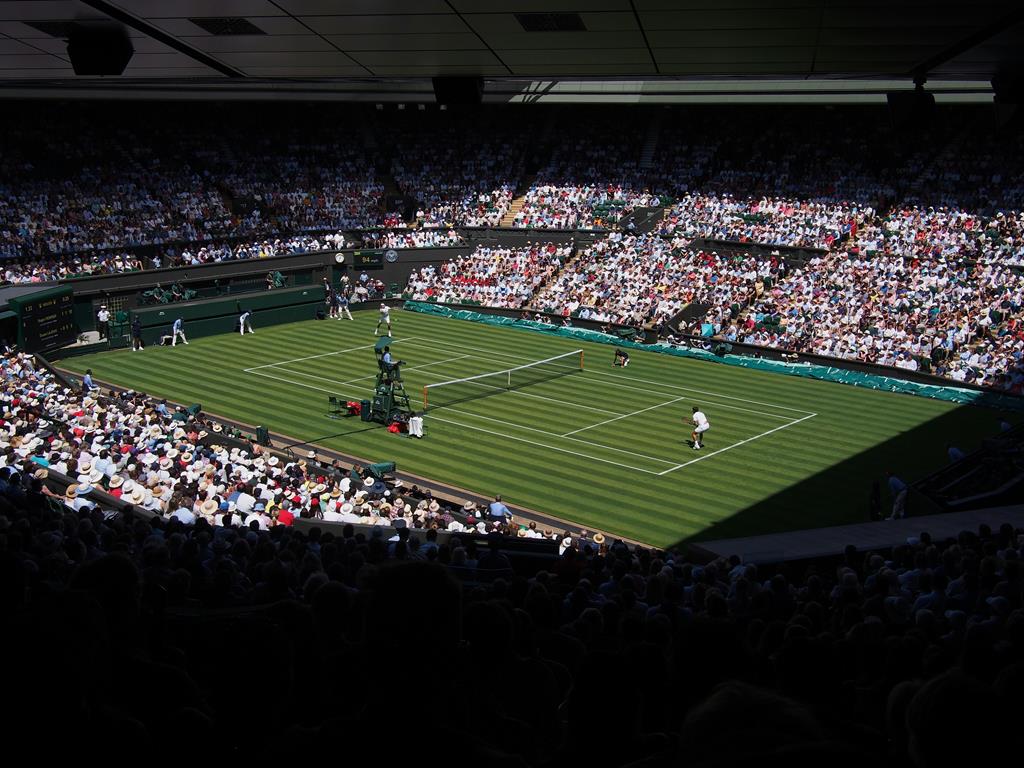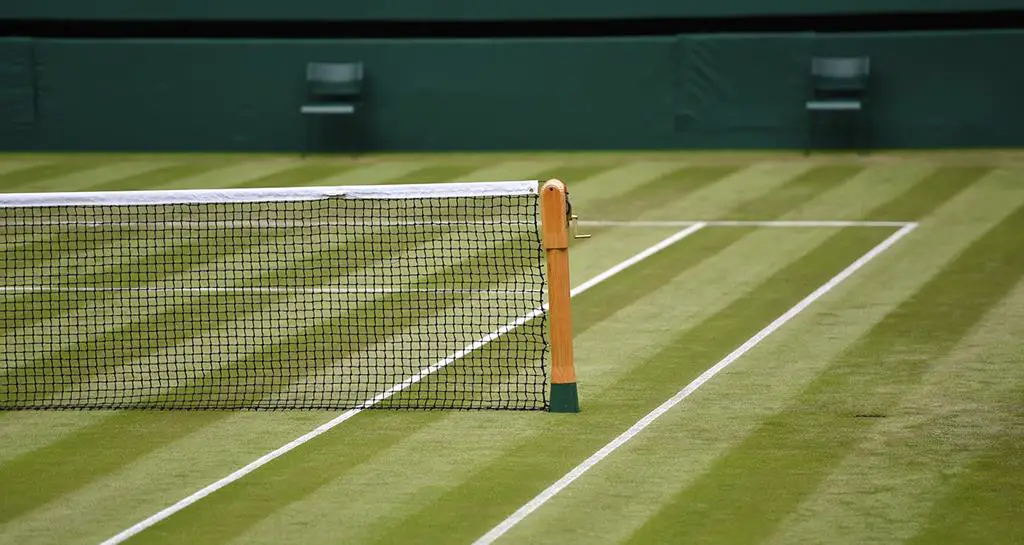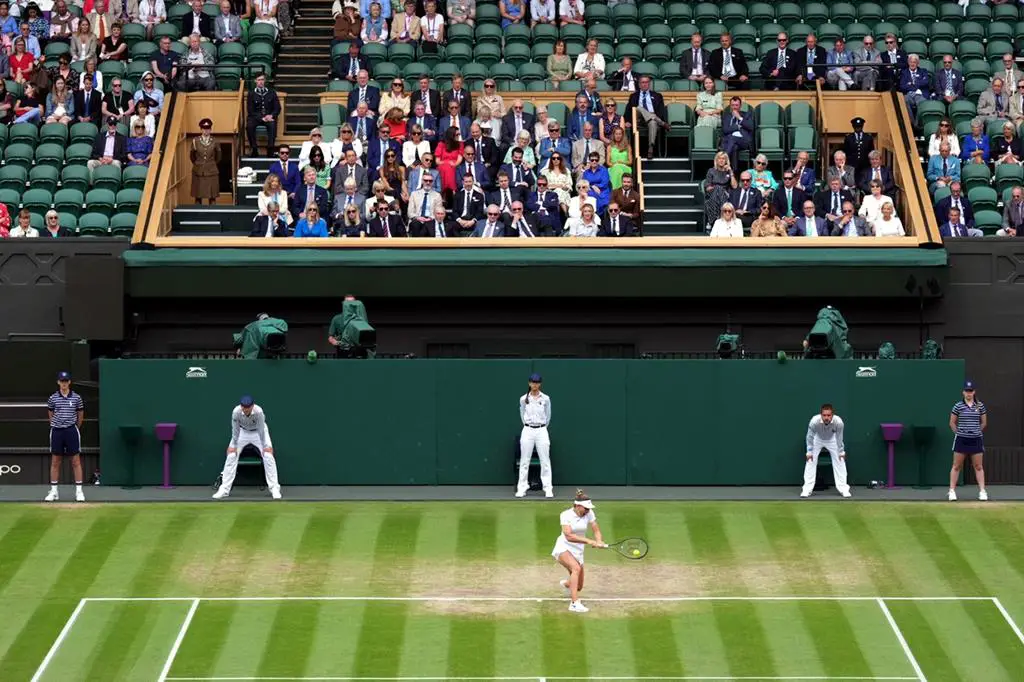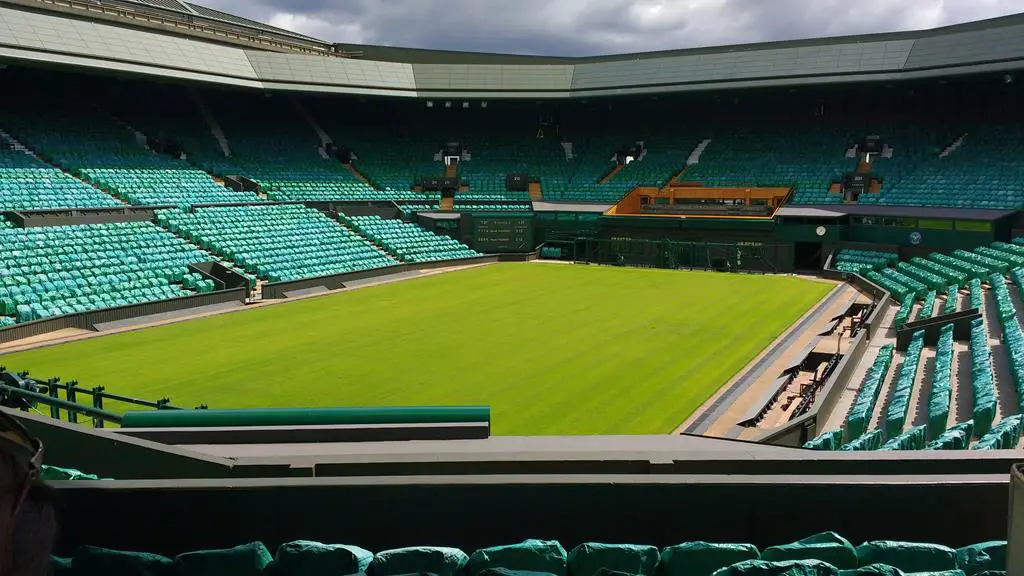The most prestigious tournament in tennis is widely considered to be Wimbledon. Known for its rich history, iconic traditions, and unparalleled elegance, Wimbledon holds a special place in the hearts of tennis players and fans alike.
The tournament’s prestigious status is attributed to its long-standing traditions, such as the all-white dress code, the Royal Box, and the absence of sponsor advertising on the courts. Additionally, the tournament’s grass courts, meticulously maintained to provide a unique playing surface, further enhance the tournament’s prestige.
The significance of the tournament is also reflected in its status as the oldest tennis tournament in the world, dating back to 1877. The tournament’s reverence, combined with its ability to attract the world’s top players, creates an atmosphere of unparalleled intensity and excitement, making it the most prestigious tournament in tennis.
Wimbledon, often called The Championships, is undeniably the most prestigious tournament in the world of tennis. Steeped in tradition, elegance, and a rich history that spans over a century, Wimbledon captivates the hearts of tennis enthusiasts and players alike. It symbolises the sport’s heritage and enduring appeal because of its meticulously maintained grass courts, iconic traditions, and unwavering commitment to excellence.
How it all started
Established in 1877, Wimbledon is the oldest tennis tournament, adding to its esteemed reputation. The tournament’s traditions, such as the all-white dress code for players, the consumption of strawberries and cream, and the royal patronage, create an aura of timeless elegance that sets it apart from any other tennis event. The hallowed grounds of the All England Lawn Tennis and Croquet Club, where Wimbledon takes place, exude a sense of unmatched grandeur and history.
The grass courts provide a unique playing surface that demands exceptional skill, agility, and adaptability from the players. The speed and low bounce of the grass require precision and finesse, making it a true test of a player’s versatility and grass-court prowess. The tournament’s commitment to maintaining these courts to the highest standards ensures that the essence of traditional tennis is preserved and celebrated.
Beyond its prestigious history and unique playing surface, the tournament attracts the world’s top players, who vie for the coveted Grand Slam title. The allure of Wimbledon lies not only in its status as a major tournament but also in the reverence and respect that players and fans have for the event. With its retractable roof, the iconic Center Court has witnessed some of the most memorable matches in tennis history, further cementing its place as the pinnacle of the sport.
With its timeless traditions, impeccable organisation, and unwavering commitment to excellence, Wimbledon embodies the essence of prestige in tennis. The tournament’s ability to seamlessly blend tradition and innovation while maintaining the highest standards of sportsmanship and fair play is a testament to its enduring appeal. It stands as a beacon of excellence, captivating the hearts of millions and rightfully earning its place as the most prestigious tournament in tennis.

The rich history of Wimbledon
The rich history of Wimbledon spans over a century, beginning with its inception in 1877 and continuing to the present day. The tournament’s origins can be traced back to the All England Lawn Tennis and Croquet Club, which was founded in 1868 with the primary purpose of promoting croquet. However, as tennis gained popularity, the club introduced a tennis tournament to its annual calendar.
The inaugural Wimbledon tournament occurred on July 9, 1877, at the club’s grounds in London. It was a modest event, with just 22 players competing in the Gentlemen’s Singles event. After defeating William Marshall in straight sets, Spencer Gore emerged as the first champion.
In the early years, Wimbledon faced challenges and changes. The tournament was initially played on a croquet lawn converted into a tennis court, complete with a net and white line. The switch from croquet to tennis marked the beginning of its journey as a dedicated tennis championship.
Over the years, Wimbledon has grown in popularity, attracting more players and spectators. 1884 the Ladies’ Singles event was introduced, making it one of the first tournaments to include women’s competition. The tournament’s reputation continued to flourish, drawing top players worldwide.
In 1922, the All England Lawn Tennis and Croquet Club moved to its current location on Church Road, expanding its facilities to accommodate the growing tournament. The iconic Centre Court was constructed in 1922-1923 and has since become synonymous with Wimbledon. It has witnessed countless historic matches and has been upgraded to meet modern standards, including adding a retractable roof in 2009.
Throughout history, Wimbledon has preserved its traditions and maintained a unique identity. The tournament’s all-white dress code for players, the consumption of strawberries and cream, and the Royal Box are just a few of the customs that have become synonymous with Wimbledon and contribute to its distinct character.
The tournament has also played a significant role in advancing the sport of tennis. It was one of the first tournaments to introduce tiebreakers, which were implemented in 1971. The introduction of equal prize money for men and women in 2007 further demonstrated its commitment to equality in sports.
Nowadays, Wimbledon continues to be one of the most prestigious and anticipated events on the tennis calendar. It is the third Grand Slam tournament of the year and attracts the world’s top players, who compete for the coveted titles. The tournament’s rich history and commitment to tradition, sportsmanship, and excellence ensures that it remains a cornerstone of the tennis world, captivating fans and players alike with its timeless allure.

Iconic tradition
Wimbledon is renowned for its iconic traditions, which have become integral to the tournament’s identity. These traditions add a unique and distinguished charm to the event, making it stand out from other tennis tournaments. Some of the most notable iconic traditions of Wimbledon include:
All-white dress code
Wimbledon is famous for its strict all-white dress code for players. Since the tournament’s early years, players have been required to wear predominantly white attire on the court. This tradition reflects Wimbledon’s emphasis on elegance, tradition, and a sense of decorum.
Strawberries and cream
Wimbledon is synonymous with the tradition of enjoying strawberries and cream. It is a quintessential treat for spectators, who indulge in this delicious combination while watching matches. The tradition dates back to the early 20th century and has become an iconic tournament symbol.
Queueing
Wimbledon is one of the few sporting events where spectators participate in the tradition of queueing. Fans line up outside the grounds, sometimes camping overnight, to secure match tickets. This tradition showcases the dedication and enthusiasm of tennis fans, creating a unique atmosphere around the tournament.
No advertising on the courts
Advertising, unlike many other sporting events. Unlike many other sporting events, The absence of commercial branding maintains the tournament’s traditional and pristine appearance, allowing the focus to remain on the game itself.
Henman Hill/Murray Mound
This grassy area outside Court No. 1 has been affectionately named “Henman Hill” and “Murray Mound” in honour of British tennis players Tim Henman and Andy Murray. Spectators gather here to watch matches on a giant screen, creating a lively and communal atmosphere.
The longest match
Wimbledon is the site of the longest tennis match in history, which occurred in 2010 between John Isner and Nicolas Mahut. The match lasted an astonishing 11 hours and 5 minutes over three days, capturing the attention and fascination of tennis fans worldwide.
These iconic traditions contribute to the unique allure of Wimbledon, creating an atmosphere that is both steeped in tradition and infused with a sense of excitement. They showcase the tournament’s commitment to upholding its rich heritage while providing a memorable experience for players and spectators alike. Wimbledon’s ability to maintain these traditions while embracing innovation and modernisation ensures that it remains an iconic and prestigious event in tennis.
Commitment to sportsmanship
Wimbledon has long been recognised for its unwavering commitment to sportsmanship in tennis. The tournament emphasises upholding the values of fair play, respect, and integrity, both on and off the court. Here are some ways in which Wimbledon demonstrates its commitment to sportsmanship:
The code of conduct
Wimbledon has a strict code of conduct to which all players must adhere. The code outlines the expected behaviour of players, coaches, and officials during matches. It strictly emphasises fair play, adherence to the game’s rules and respect for opponents. Any violations of the code can result in penalties or disciplinary action.
Respect for opponents
Wimbledon promotes respect for opponents as a fundamental aspect of sportsmanship. Players are expected to show respect to their opponents before, during, and after matches. This includes shaking hands at the net, acknowledging good shots, and avoiding unsportsmanlike behaviour such as taunting or disrespecting opponents.
Post-match press conferences
After matches, players must attend press conferences where they answer questions from journalists. During these interviews, Wimbledon encourages players to display good sportsmanship by being gracious in victory and dignified in defeat. This helps foster a culture of respect and professionalism.

Umpire and line judge respect
Wimbledon emphasises respect for umpires and line judges, which is crucial in officiating matches. Players are expected to accept their decisions gracefully and refrain from showing dissent or disrespect. Any disputes or disagreements are handled with professionalism and respect for the officials’ authority.
Honouring opponents and champions
Wimbledon has a tradition of honouring opponents and champions. Regardless of the outcome, finalists are recognised and applauded during the trophy presentations. This gesture exemplifies the tournament’s commitment to acknowledging and appreciating the efforts and achievements of all players.
Ethical conduct
Wimbledon strongly stands against cheating or unethical behaviour in tennis. The tournament takes allegations of match-fixing, doping, and other violations very seriously and collaborates with tennis governing bodies and anti-doping agencies to ensure the integrity of the sport.
Sportsmanship awards
Wimbledon celebrates and recognises exceptional sportsmanship through various awards. The Wimbledon Foundation, in partnership with the International Tennis Federation, presents the “Wimbledon Foundation International Tennis Integrity Award” to individuals or organisations that promote integrity and sportsmanship in tennis.
By consistently upholding these principles and encouraging a culture of fair play, Wimbledon sets a high standard for sportsmanship in tennis. The tournament’s commitment to these values helps foster an environment of respect, integrity, and fair competition, ensuring that Wimbledon remains a beacon of sportsmanship in the tennis world.
Global recognition
Wimbledon enjoys unparalleled global recognition as one of the world’s most prestigious and iconic tennis tournaments. Its reputation extends far beyond the boundaries of the sport, captivating audiences from diverse backgrounds and cementing its status as a cultural phenomenon. Several factors contribute to Wimbledon’s global recognition:
Grand slam status
Wimbledon is one of the four Grand Slam tournaments in tennis, along with the Australian Open, French Open, and US Open. As a Grand Slam event, Wimbledon holds a special place in the tennis calendar, attracting the world’s top players and generating significant media coverage and public interest.
Historic significance
With its origins dating back to 1877, Wimbledon holds a place of historical significance in tennis. Its rich heritage, traditions, and status as the oldest tennis tournament have helped shape its global recognition. Wimbledon’s long-standing history adds a sense of gravitas and authenticity that resonates with fans and players alike.
Grass court legacy
Wimbledon is the only Grand Slam tournament played on grass courts. The tournament’s unique surface, with its fast-paced and low-bouncing nature, requires a specific set of skills and strategies. This distinct playing surface adds to the allure of Wimbledon and sets it apart from other tournaments, garnering global attention and interest.

Global broadcast reach
Wimbledon’s matches are broadcast in over 200 countries, allowing fans worldwide to tune in and witness the tournament’s action. The extensive coverage ensures that Wimbledon reaches a vast and diverse audience, transcending geographical boundaries and uniting tennis enthusiasts worldwide.
Cultural significance
Wimbledon has become a cultural event that extends beyond the sport of tennis. The tournament’s traditions, such as the all-white dress code, strawberries and cream, and the Royal Box, have become iconic symbols associated with British culture and summer traditions. This cultural significance adds to the global recognition of Wimbledon, attracting sports fans.
Global stars and rivalries
Wimbledon has been the stage for some of the most legendary players in tennis history. The tournament has witnessed extraordinary talent and fierce rivalries from Bjorn Borg and Martina Navratilova to Roger Federer and Serena Williams. These global stars and their memorable performances at Wimbledon contribute to its global recognition and draw in fans worldwide.
Prestige and tradition
Wimbledon’s unwavering commitment to tradition, excellence, and sportsmanship has solidified its reputation as a prestigious tournament. The tournament’s strict adherence to its traditions, impeccable organisation, and historic venue.
These factors have elevated Wimbledon to unparalleled global recognition in tennis. Its status as one of the most prestigious tournaments, historical significance, unique playing surface, extensive broadcast reach, cultural importance, and the presence of global stars all contribute to its enduring appeal and global recognition. Wimbledon’s ability to consistently captivate audiences worldwide is a testament to its iconic status in sports.
The exclusive venue of Wimbledon
Wimbledon’s exclusive venue adds to the allure and prestige of the tournament. The All England Lawn Tennis and Croquet Club, located in Wimbledon, London, has been the exclusive venue for the tournament since its inception in 1877. Here are some key aspects of the exclusive venue:
The All-England Club
The All England Lawn Tennis and Croquet Club, commonly known as the All England Club, is the private members’ club that hosts the Wimbledon tournament. The club has a rich history and is renowned for its impeccable facilities and well-maintained grass courts.
The grounds
The Wimbledon grounds are meticulously maintained and embody elegance and tradition. The lush green lawns, manicured gardens, and iconic ivy-covered walls create a picturesque setting for the tournament. The grounds have expanded over the years to accommodate the growing event, providing ample space for spectators, players, and various facilities.
Centre court
Centre Court is the most iconic and prestigious venue within the Wimbledon grounds. It has a seating capacity of around 15,000 spectators and is the focal point of the tournament. Centre Court has witnessed numerous historic matches and is equipped with a retractable roof, allowing play to continue during inclement weather.
No. 1 court and outer courts
In addition to Centre Court, Wimbledon features several other courts, including No. 1 Court, which is the second-largest venue at the tournament. The outer courts provide a more intimate setting for matches, allowing fans to be closer to the action and creating a unique atmosphere.
Clubhouse and members’ facilities
The All England Club features a clubhouse that offers exclusive facilities for its members, including dining areas, bars, and lounges. These areas provide a luxurious and intimate space for members and guests to enjoy the tournament.
Tradition and exclusivity
Wimbledon’s exclusive venue contributes to its reputation as one of the most prestigious tournaments in tennis. The tournament’s commitment to tradition, including its all-white dress code and strict adherence to etiquette, adds to the sense of exclusivity and elegance associated with Wimbledon.
The exclusive venue of Wimbledon reflects the tournament’s commitment to providing a unique and distinguished experience for players, spectators, and members of the All England Club. The meticulously maintained grounds, iconic courts, and exclusive facilities contribute to the tournament’s status as a symbol of excellence and tradition in tennis.
The Royal Patronage
The Wimbledon tournament enjoys a long-standing tradition of royal patronage, with members of the British royal family playing a significant role in the event. Here is an overview of the royal patronage in Wimbledon:
Royal Family attendance
The British royal family members, including the Queen, have been regular attendees at Wimbledon throughout its history. Their presence adds a touch of regal glamour and prestige to the tournament. The royal family’s interest in tennis and attendance at Wimbledon helped elevate the event’s status and global recognition.
The Royal Box
Wimbledon features a special seating area known as the Royal Box, located on Centre Court. This exclusive section is reserved for members of the royal family and other distinguished guests. It offers a prime viewing position and a unique experience for those invited to sit in the Royal Box.

Royal trophy presentations
The royal family has presented trophies to the tournament winners. A royal family member, often the Duke or Duchess of Kent, presents the trophies to the champions during the trophy ceremonies. This adds a special touch to the awarding of the trophies and further highlights the royal patronage of the event.
Royal visits and engagements
Besides attending matches and presenting trophies, royal family members may visit the grounds during the tournament. They may engage in activities such as meeting players, interacting with officials, and participating in charitable initiatives associated with the tournament. These engagements further strengthened the bond between the royal family and Wimbledon.
The All-England club membership
The All England Lawn Tennis and Croquet Club, which hosts Wimbledon, is closely associated with the royal family. Several royal family members have been honorary club members, emphasising the special connection between Wimbledon and the monarchy.
The royal patronage in Wimbledon adds a sense of tradition, prestige, and grandeur to the tournament. The royal family’s presence, attendance at matches, the Royal Box, and involvement in trophy presentations create a unique and distinguished atmosphere. This patronage enhances the tournament’s reputation and showcases the royal family’s support for tennis and their commitment to promoting sports and cultural events in the United Kingdom.
The meticulously maintained grass courts
Wimbledon’s grass courts are meticulously maintained and play a significant role in the tournament’s identity and unique playing conditions. Here is an explanation of the meticulous care and attention given to the grass courts at Wimbledon:
Selection of grass
The grass used at Wimbledon is a specific variety of perennial ryegrass called “Lolium perenne.” This type of grass is chosen for its durability, ability to withstand heavy foot traffic and suitability for tennis play. The selection process ensures the grass can withstand matches’ intense wear and tear throughout the tournament.
Year-round preparation
Preparing the grass courts for Wimbledon is year-round. After the tournament ends, the courts undergo rejuvenation and renovation. This includes overseeding, aeration, and careful maintenance to ensure the grass recovers and regenerates.
Height and density
The grass on Wimbledon’s courts is maintained at a specific height and density to create the desired playing conditions. The grass is kept relatively short, typically around 8 to 10 millimetres in height, to allow for a fast-paced and low-bouncing surface. The grass density is carefully managed to provide a consistent and even playing surface.

Daily maintenance
The grass courts receive meticulous daily maintenance during the tournament. This includes mowing the grass to the desired height, rolling the courts to create a smooth surface, and watering to maintain optimal moisture levels. The courts are also brushed to remove debris and maintain an even and uniform surface.
Protection and covering
Wimbledon has a unique feature – retractable roofs on Centre Court and No. 1 Court to protect the grass courts from inclement weather. These roofs can be closed during rain or adverse weather conditions, allowing play to continue and protecting the grass from damage. Covers shield the courts overnight, preventing dew or frost from affecting the playing surface.
Court rotation
The grass courts are rotated throughout the tournament to ensure fairness and equal playing conditions. This means that matches are not always played on the same court, allowing the grass to recover and reducing wear and tear in specific areas.
Expert groundskeeping
Wimbledon’s groundskeeping team consists of experienced professionals who have extensive knowledge and expertise in maintaining grass courts. They meticulously monitor the condition of the courts, make necessary adjustments, and ensure that the playing surface meets the tournament’s high standards.
The meticulous care and attention given to Wimbledon’s grass courts result in a unique playing surface that requires players to adapt their game. The fast-paced, low-bouncing nature of the grass courts presents a challenge and adds to the tournament’s distinctiveness. The commitment to maintaining the grass courts at Wimbledon ensures that the tournament continues to showcase the traditional and exceptional grass-court tennis that has become synonymous with the event.
For even more content like this, check out our tennis page.


Trackbacks/Pingbacks